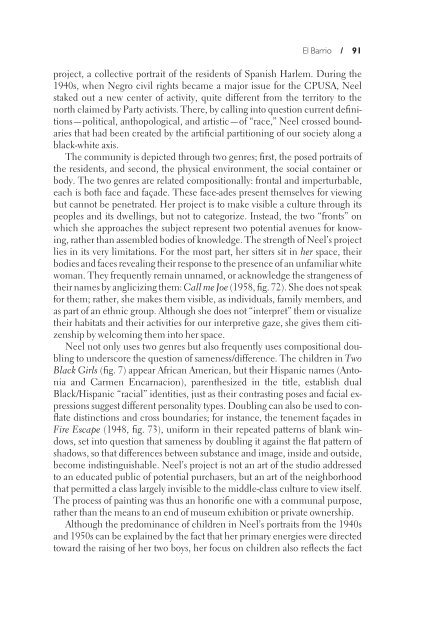i-xxii Front matter.qxd - Brandeis Institutional Repository
i-xxii Front matter.qxd - Brandeis Institutional Repository
i-xxii Front matter.qxd - Brandeis Institutional Repository
Create successful ePaper yourself
Turn your PDF publications into a flip-book with our unique Google optimized e-Paper software.
El Barrio / 91project, a collective portrait of the residents of Spanish Harlem. During the1940s, when Negro civil rights became a major issue for the CPUSA, Neelstaked out a new center of activity, quite different from the territory to thenorth claimed by Party activists. There, by calling into question current deƒnitions—political,anthopological, and artistic—of “race,” Neel crossed boundariesthat had been created by the artiƒcial partitioning of our society along ablack-white axis.The community is depicted through two genres; ƒrst, the posed portraits ofthe residents, and second, the physical environment, the social container orbody. The two genres are related compositionally: frontal and imperturbable,each is both face and façade. These face-ades present themselves for viewingbut cannot be penetrated. Her project is to make visible a culture through itspeoples and its dwellings, but not to categorize. Instead, the two “fronts” onwhich she approaches the subject represent two potential avenues for knowing,rather than assembled bodies of knowledge. The strength of Neel’s projectlies in its very limitations. For the most part, her sitters sit in her space, theirbodies and faces revealing their response to the presence of an unfamiliar whitewoman. They frequently remain unnamed, or acknowledge the strangeness oftheir names by anglicizing them: Call me Joe (1958, ƒg. 72). She does not speakfor them; rather, she makes them visible, as individuals, family members, andas part of an ethnic group. Although she does not “interpret” them or visualizetheir habitats and their activities for our interpretive gaze, she gives them citizenshipby welcoming them into her space.Neel not only uses two genres but also frequently uses compositional doublingto underscore the question of sameness/difference. The children in TwoBlack Girls (ƒg. 7) appear African American, but their Hispanic names (Antoniaand Carmen Encarnacion), parenthesized in the title, establish dualBlack/Hispanic “racial” identities, just as their contrasting poses and facial expressionssuggest different personality types. Doubling can also be used to con-„ate distinctions and cross boundaries; for instance, the tenement façades inFire Escape (1948, ƒg. 73), uniform in their repeated patterns of blank windows,set into question that sameness by doubling it against the „at pattern ofshadows, so that differences between substance and image, inside and outside,become indistinguishable. Neel’s project is not an art of the studio addressedto an educated public of potential purchasers, but an art of the neighborhoodthat permitted a class largely invisible to the middle-class culture to view itself.The process of painting was thus an honoriƒc one with a communal purpose,rather than the means to an end of museum exhibition or private ownership.Although the predominance of children in Neel’s portraits from the 1940sand 1950s can be explained by the fact that her primary energies were directedtoward the raising of her two boys, her focus on children also re„ects the fact
















